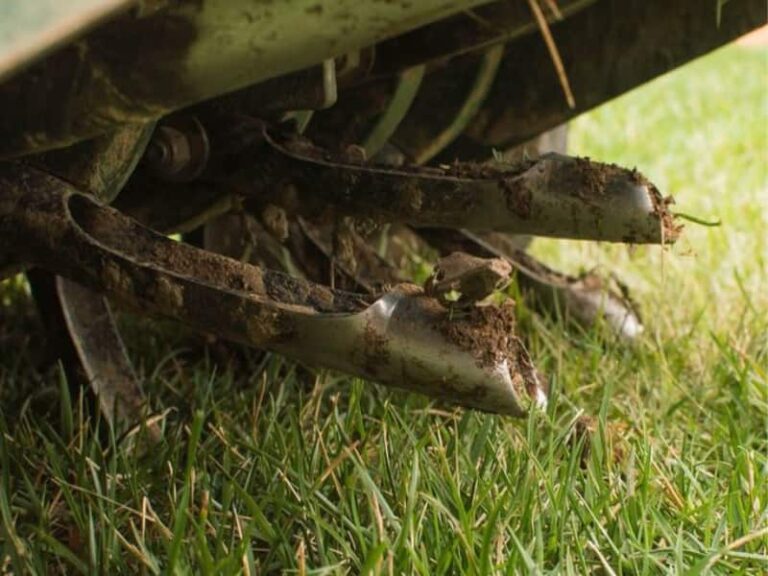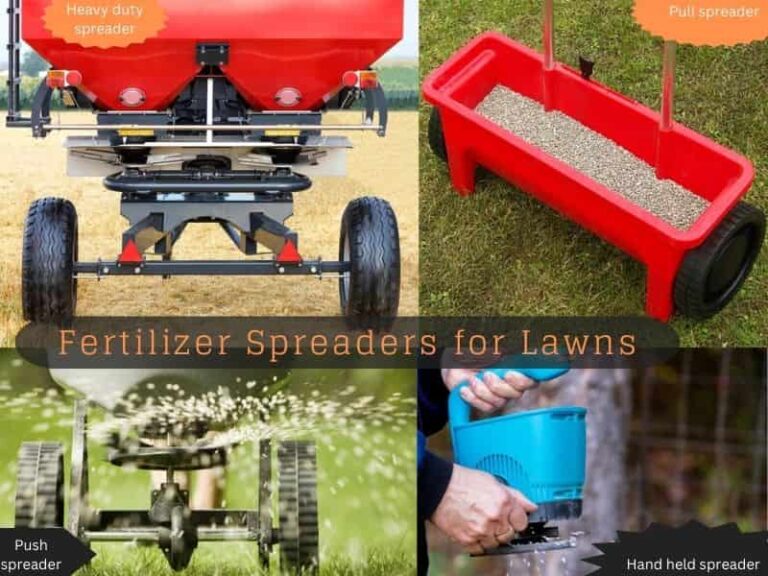Can You Put Too Much Lime on Lawn? (How Much & Ways to Fix Excess)
Changes in soil pH cause significant effects on turfgrass. The correct amount of lime is often recommended for lawns with low pH. Unfortunately, many people often apply too much lime on their lawns. The resultant alkaline conditions hurt grass growth and ruin the lawn’s aesthetic appeal.
It is easy to put too much lime lawn treatment when trying to reduce soil pH. Excess lime (generally above 50 pounds per 1000 sq ft) on turfgrass spikes pH, making the soil too alkaline and preventing nutrient uptake. The increase in calcium and deficiencies in vital nutrients turn the grass yellow.
Table of Contents
How much lime to put on the lawn?
Generally, you should not put more than 50 pounds per 1000 square feet per application. If more than 50 pounds of lime amendment is recommended, you should divide it into two or three applications per year.
The only way to determine how much to apply is through a soil test conducted by a soil testing laboratory. Get a soil analysis test from your local County Extension Office. The test determines the soil pH and the type of soil found on your lawn.

Different forms of lime that you can apply on the lawn. However, ground dolomite is one of the best options. Consult a lawn care professional who’ll walk you through various options.
Lime is applied only when the soil is too acidic for turfgrass growth. Soil becomes nutrient-deficient when the soil pH drops lower than 6.0. Applying lime restores balance.
Cool-season grasses like Kentucky bluegrass, Fescues, and ryegrass prefer alkaline pH between 6.5 and 7.2. In contrast, warm-season grass like Zoysia grass, Bermuda grass, and Centipede grass prefer a slightly acidic pH between 6.0 and 6.5.
You can add lime anytime. However, spring is the best time when the soil warms up. You can also add it in fall or winter during the freeze-thaw cycle.
Avoid applying lime to dormant or stressed grass.
See Also: Limestone for grass
Can You Put Too Much Lime on a Lawn?
Balancing the soil pH can be a difficult task. While timely application of lime is a corrective measure, putting too much lime on your lawn is possible. Usually, putting too much is either accidental or a result of you not knowing the current pH status of the soil.
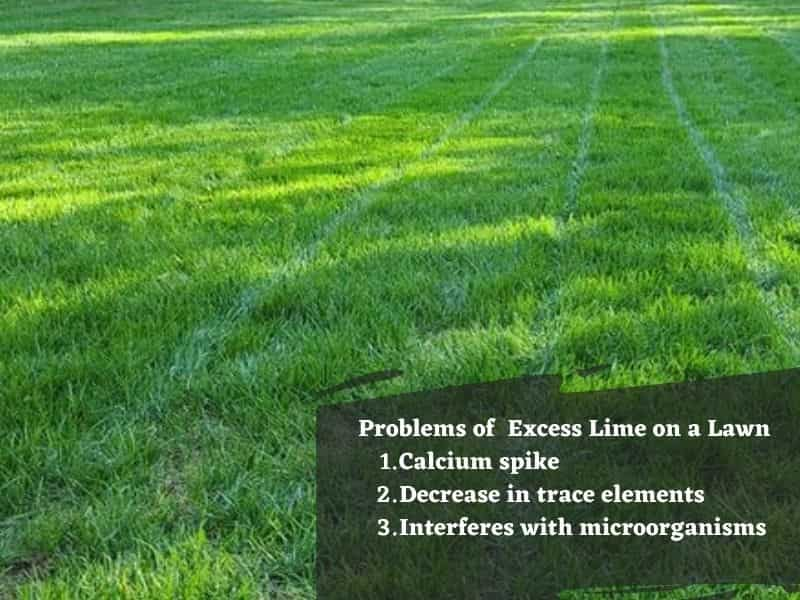
You can apply multiple types of lime: granular, powder and liquid lime. Granular lime comes in pellets that can be easily and evenly applied with a broadcast or drop spreader. Powdered lime is best applied by hand since it’s too fine for most fertilizer spreaders. Liquid lime can only be applied with a sprayer, making it more difficult to determine the amount applied. As such, powder and liquid lime may be applied much more than required for the lawn.
Here are the common problems caused by too much lime:
Calcium spike in the soil.
Lime is either calcium hydroxide or calcium oxide. Too much agricultural lime (ground limestone) increases the calcium in the soil. Excess calcium and high pH limit turfgrass’s ability to absorb certain nutrients leading to deficiency, the most common being iron deficiency.
Most turfgrass’s optimum pH level for growth is between 6.0-7.0. Bermuda grass 6-7, Zoysia 6-7, Kentucky bluegrass 6-7. If the pH for these turfgrasses falls below 5.5, it will compromise their growth. Centipede grass tolerates slightly acidic and should not be limed unless its pH is less than 5.0.
A decrease in trace elements
Excess lime causes a decrease in trace elements such as zinc, boron, magnesium, and copper. These nutrients are vital for turfgrass growth and survival. An upset in the balance of these elements also upsets the pH balance and weakens the soil.
Upset in microorganism ecosystem
The high pH environment from excess lime is not conducive to microorganisms that benefit the turfgrass. Microbes such as fungi and algae thrive in neutral and slightly acidic 6-7pH soil. Microbes are vital in breaking down nutrients like those found in organic fertilizers.
Alkaline soils caused by over-liming create dense and compact soils caused by soil dispersion.
The table below helps you calculate the amount of lime you should apply on your lawn to avoid over-liming.
| Soil Type | Amount lbs/1000ft2 for pH 4.5 | Amount lbs/1000ft2 for pH 5.5 |
| Sand and Sandy Loam | 30-50 | 20-30 |
| Loam | 45-75 | 80-130 |
| Clay Loam and Clay | 90-100 | 150-190 |
Soils with higher clay content and organic matter need more lime to neutralize the acidity than sandy soils with lower organic matter.
For example, if your lawn has sandy loam soils with a pH of 5.5, and you wish to raise it to 6.5, you need 20 to 30 pounds of lime.
Other modifying factors will affect the liming rate. These factors include soils in areas with naturally occurring limestone and watering with water that contains lime.
How to fix too much lime on the lawn
Get a soil pH test before fixing the over-liming problem. If the test indicates high soil pH, use one of the following methods to fix it.
Apply ample amounts of organic material
Organic matter such as straw, alfalfa meal, or manure effectively reduces over-liming effects. The decomposed organic matter releases carbon dioxide, which forms carbonic acid.
Organic matter is an easy and affordable way to neutralize the alkaline lawn.
Add an acidic substance
Acidic substances such as horticultural sulfur neutralize the lawn and restore a balanced pH. Sulfur is inexpensive and readily available in gardening stores.
Iron Sulfate is also an effective product that temporarily acidifies the soil. You can add sulfuric acid directly to the soil to correct excess lime. You may also use ironite on lawns to provide needed iron nutrients and temporarily acidify the soil.
Irrigate or flush the soil
Watering or rainfall will reduce the pH of your lawn. Over time rain or irrigation will wash away the alkaline elements.
Fertilize the soil
Applying acidifying fertilizers lowers the soil’s pH. Fertilizers such as Ammonium sulfate create nitrate and hydrogen ions that lower the pH.
Caution: Over-applying Ammonium sulfate or sulfur in the lawn damages turfgrass.
Does lime hurt grass?
Lime, in correct amounts, is highly beneficial to grass. However, it will hurt grass only if used in excess.
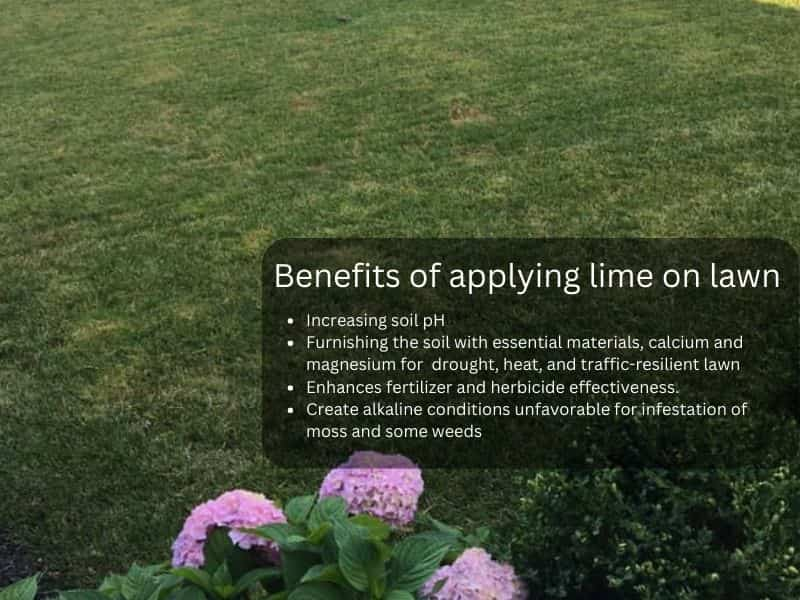
Some of the benefits of applying lime include the following:
- Lime replaces hydrogen, increasing soil pH.
- Furnishing the soil with essential materials such as calcium and magnesium. These nutrients help grass retain color. Calcium makes the lawn resilient during drought, heat, and traffic.
- Lime also increases fertilizer and herbicide effectiveness. This is due to strengthened turfgrass and weakened weeds.
- Moss and some weeds thrive in acidic conditions. Using lime in your lawn will create alkaline conditions unfavorable for infestation.
Still, an incorrect lime application has adverse effects on turfgrass.
Over-liming creates alkaline soil conditions, which help weeds and weedy grasses encroach on the lawn. It also spikes calcium levels which results in large pores in the soil. Large pores dry out the soil.
The symptoms of over-liming the lawn include discolored brown turfgrass, knotted roots, and eventual grass death. The roots of newly established turfgrass become underdeveloped, reducing nutrient uptake.
Note: applying less lime is better than applying excess lime. You can always add lime.
How long does it take for lime to raise pH?
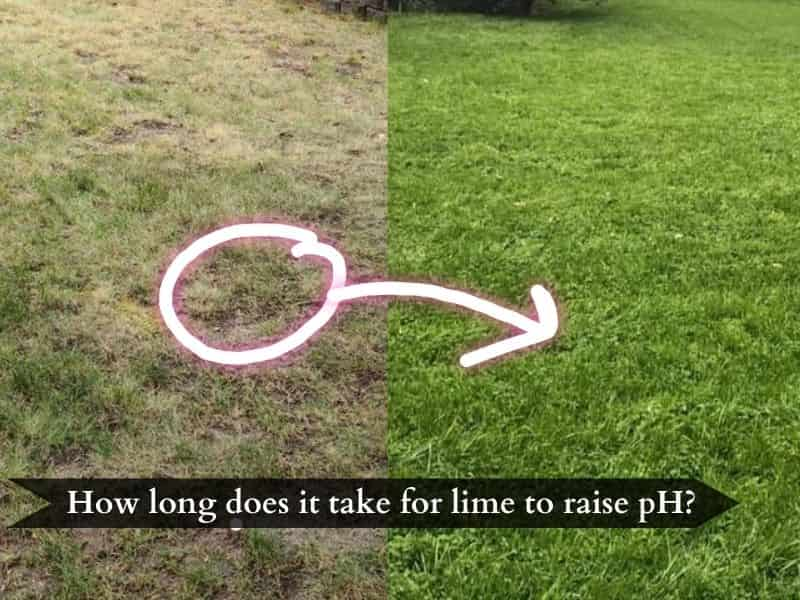
Lime takes a few months to break down and raise the pH. While you might see the benefits of lime in as little as six weeks, it takes 2-3 years to react with the soil completely.
Check the soil pH after 1-2 years to determine if it needs more lime.
The reactivity of lime depends on the type of lime used. Lime with a high amount of calcium carbonate neutralizes soil acidity faster. Fine liming material works faster than coarse lime.
Water also determines the reactivity of lime. Liming requires water to dissolve. It might take longer In dry soil. Irrigation or rainfall shortens the time needed for lime to dissolve in the soil.
Can you use too much Dolomite Lime?
Applying too much lime on your lawn will effectively reduce the soil acidity but ultimately make it too alkaline for the grass to thrive and flourish. Yellowing grass is the main symptom of too much lime, which inhibits the soil’s absorption of vital moisture and nutrients.
When should I use Dolomite Lime?
Dolomite lime is a slow-release lime that takes 2-3 months, so add it to your lawn any time (spring or fall) there’s no frost or freezing temperatures. However, avoid rainy days so that dolomite won’t wash off the soil before it’s absorbed. You can reapply it three to four times a year if the need arises.
Do I need to water the lawn after applying lime?
The best time to apply lime is after rain. Water your lawn after lime application to activate it for reaction in soil. Dry soil may take a while, whereas application in moist soil should take at least a year to start experiencing positive results. Watering also prevents grass blade burns from lime
Should I lime my lawn before or after mowing?
Lime is best applied in Autumn or Winter when your lawn may not need mowing. However, if need be, you can mow your lawn and apply the lime since it takes time for it to work, although we recommend you aerate the lawn with a core aerator to open up space for the lime to move into the soil effectively.
Can you mow after putting down lime?
It’s best to mow first before putting down lime. In addition, we don’t recommend seeding or applying fertilizer before and after liming your lawn.
Final Thought
Low Soil pH levels limit the grass’s access to nutrients to thrive and flourish. Correct lime application corrects the soil acidity to optimum levels making it “sweeter” for lawn grass establishment and growth. The lime soil amendments alters the soil pH levels, improving your grass’s ability to access nutrients in your soil.

